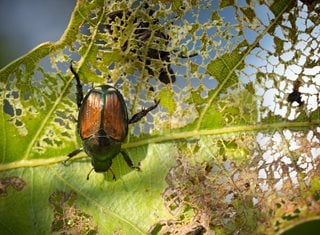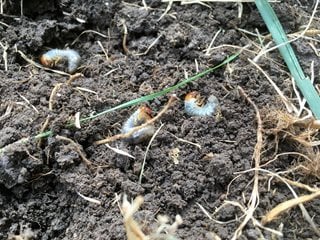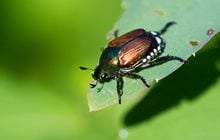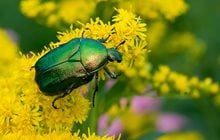GETTING RID OF JAPANESE BEETLES
Learn ways to deal with Japanese beetle infestations naturally
Japanese beetles usually feed in small groups, leaving devastated, skeletonized leaves behind. Photo by: Kent Sievers / Shutterstock.
Japanese beetles don’t discriminate when it comes to the plants they feed on. They are most commonly found on roses, grapes, beans and raspberries, but they will prey on hundreds of different plant species. Recognized as a major threat to crops in the Eastern and Midwest U.S., Japanese beetles can be difficult to control. Not only are they persistent pests, but new adults emerge daily over a period of several weeks. It takes determination and repeated efforts to get the upper hand on them.
8 JAPANESE BEETLE CONTROL METHODS
- Hand pick adult beetles: This can be the most effective way to gain control, but does require daily attention, often for weeks, as long as the beetles are actively feeding. The best time of day is early morning, while they are still sluggish. Place a drop cloth under affected plants and shake them to dislodge the beetles. Collect the beetles and drop them into a bucket of soapy water. Remove any damaged leaves, as they emit feeding-induced odors that can attract more beetles.
- Japanese beetle traps: This method can provide mixed results. While the beetle traps do a good job of catching the beetles that crawl into them, their bait may actually attract more beetles from surrounding areas, causing more harm than good. If used, they should be placed far away from any plants that beetles could harm.
- Neem oil: Used as a botanical insecticide, neem oil reduces feeding of the insects. It is best applied at the very first sign of damage. When applied properly, neem oil is safe for honeybees and other beneficial insects. For other insecticides, contact your local cooperative extension services for approved insecticides in your area. (Read more on how to use neem oil.)
- Create a barrier: Use row covers over ground crops during the 6- to 8-week feeding period.
- Trap crops: Planting sacrificial crops of highly favored plants away from desired crops can draw adult beetles away. You will still need to trap or kill the beetles on these sacrificial crops to keep them from becoming a bigger problem.
- Plant selection: If you’re in an area that is often plagued by Japanese beetles, your best bet is to avoid vulnerable plants such as roses, grapes, beans, raspberries, rose of Sharon, apple, crabapple, cherry, mountain ash, birch, American & English elm, linden, crape myrtle, and pin oak. At the very least, use them sparingly and disperse them throughout your landscape so you’re not providing one large buffet table.
- Resistant plants: Replace susceptible plants with more resistant choices like boxwood, dogwood, hemlock, holly, magnolia, red and silver maple, oaks, sweet gum, and tulip tree, euonymus and common lilac.
- Companion planting: Incorporate plants that repel Japanese beetles such as catnip, chives, garlic, odorless marigold, nasturtium, white geranium, rue, or tansy near susceptible plants to help keep the beetles away.
For more on plant selection, see Japanese Beetle Food Preferences, from Iowa State University.
HOW TO PREVENT JAPANESE BEETLES
Treating Japanese beetles in their larval stage, as grubs, can significantly decrease the threat of the adult beetles and lays the ground work for long-term control. Grubs are best treated in your lawn in late summer through fall and again in spring, when they are actively feeding. There are a number of ways to deal with Japanese beetle grubs naturally:
- Beneficial nematodes: Spray your lawn and garden with beneficial nematodes for natural, biological control of Japanese beetles. Nematodes seek out grubs (and over 200 other pests that live in the soil) and kill them. This method is completely safe for people, pets, plants and beneficial insects. There are different strains of nematodes. Both the Sf (Steinernema feltiae) and Hb (Heterorhabditis bacteriophora) strains target grubs, but you may have better success specifically for Japanese beetle grubs with the Hb nematodes.
- Milky spore: For long-term control, milky spore powder (Bacillus popilliae) is another naturally-occurring killer of grubs. It does take a while to become effective, often 2 to 3 years, but will multiply with each grub it kills and remain viable in the soil for years. Use another method, such as nematodes, while waiting for the milky spore to gain hold.
- Bacillus thuringiensis (Bt) ssp galleriae strain SDS-502, also known as grubHalt-Bt for Lawn Pests is a non-chemical granule that is applied and watered in. This strain of Bt should not be confused with the more common Bacillus thuringiensis ssp. kurstaki, because this strain does not treat grubs. All forms of Bt can be harmful to butterfly caterpillars, including monarchs, so use care not to apply where or when butterflies or caterpillars are present. The product does degrade rapidly and won’t affect caterpillars beyond 10 days after final treatment. Buy grubHalt-Bt for Lawn Pests from Gurney's.
- Birds: Attract natural predators of grubs, such as birds, by providing houses for them. Grubs can be coaxed to the surface by spraying the lawn with a solution of 2T liquid dish soap in 1 gallon of water per 1000 square feet.
For more information, see Getting Rid of Grub Worms Naturally.
JAPANESE BEETLES ON ROSES
Roses are one of the most highly favored plants of Japanese beetles, and one that home gardeners seem to struggle with the most. It is recommended that a two-fold approach be used: a prevention technique, such as milky spore or nematodes, along with a Japanese beetle spray that targets the adult beetles. However, be careful when spraying because you don’t want to kill the grubs with the spray. Doing so will halt the natural sequence of the milky spore or nematodes and the future benefit that they provide by multiplying once they have killed a grub. There is also a 3-in-1 spray that combines neem oil with ingredients that help with black spot, powdery mildew, spider mites, aphids and whiteflies.
If your roses are completely overrun with beetles, you may find that snipping off the buds and spraying the leaves is your only option. Hopefully your rose bush will recover enough to bloom again once the threat is gone.
JAPANESE BEETLE LIFE CYCLE
Adult female beetles lay eggs in the soil in early June. The eggs hatch in about 2 weeks and the developing Japanese beetle larvae (white grubs) feed on organic matter and grass roots until late fall. They overwinter deep in the soil and resurface again in spring when soil temperatures rise, to feed for another 3 to 4 weeks before emerging as adult Japanese beetles. Adult beetles have a lifespan of about 40 days.
HOW TO TELL A JAPANESE BEETLE FROM A GREEN JUNE BEETLE
RELATED:
How to Get Rid of Grubs
How to Get Rid of Whiteflies
How to Get Rid of Spider Mites



